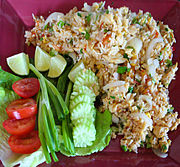
There are many different sorts of noodles and many different sizes. They come in fresh and dried forms and are made from rice, wheat or mung beans. If it is possible we recommend to use fresh noodles. Yellow or egg noodles are yellow because egg yolk is added and they are used for noodle coup. Noodles are used in stir-frieds, soups and salads.
If you use dried noodles then they need to be soaked in water for 15-20 minutes before using. They are then ready to be stir-fried. If they are to be used for noodle soup, they need to be put into the hot soup for about 2 minutes. Fresh noodles do not need to be soaked and can be put straight into the soup. If they are needed quickly then the dried noodles can be put into boiling water for 3-5 minutes and once they are soft they are transferred into cold water and then they are ready to be used.
Rice vermicelli which are to be deep-fried for a crispy noodle dish do not need to be soaked. They can just be fried in hot oil.
Bean vermicelli or glass noodles are made from mung beans. They need to be soaked in water for 5 minutes before using. If they are going to be used for a salad then they need to be put into boiling water after they have been soaked and then transferred into cold water.






